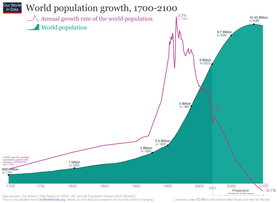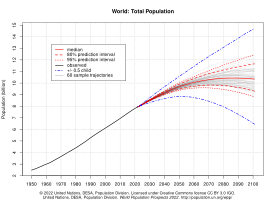
Back توقعات النمو السكاني Arabic Becslések a Föld népességére Hungarian 세계 인구 예측들 Korean آبادی میں متوقع اضافہ Urdu

Population projections are attempts to show how the human population statistics might change in the future.[1] These projections are an important input to forecasts of the population's impact on this planet and humanity's future well-being.[2] Models of population growth take trends in human development and apply projections into the future.[3] These models use trend-based-assumptions about how populations will respond to economic, social and technological forces to understand how they will affect fertility and mortality, and thus population growth.[3]
The 2022 projections from the United Nations Population Division (chart #1) show that annual world population growth peaked at 2.3% per year in 1963, has since dropped to 0.9% in 2023, equivalent to about 74 million people each year, and projected that it could drop even further to minus 0.1% by 2100.[4] Based on this, the UN projected that the world population, 8 billion as of 2023[update], would peak around the year 2086 at about 10.4 billion, and then start a slow decline, assuming a continuing decrease in the global average fertility rate from 2.5 births per woman during the 2015–2020 period to 1.8 by the year 2100, (the medium-variant projection).[5][6]
However, estimates outside of the United Nations have put forward alternative models based on additional downward pressure on fertility (such as successful implementation of education and family planning goals in the UN's Sustainable Development Goals) which could result in peak population during the 2060–2070 period rather than later.[3][7]
According to the UN, of the predicted growth in world population between 2020 and 2050, all of that change will come from less developed countries, and more than half will come from sub-Saharan Africa.[8] Half of the growth will come from just eight countries, five of which are in Africa.[5][6] The UN predicts that the population of sub-Saharan Africa will double by 2050.[8] The Pew Research Center observes that 50% of births in the year 2100 will be in Africa.[9] Other organizations project lower levels of population growth in Africa, based particularly on improvement in women's education and successful implementation of family planning.[10]

During the remainder of this century some countries will see population growth, some will see population decline. For example the UN projects that Nigeria will gain about 340 million people, about the present population of the US, to become the 3rd most populous country, and China will lose almost half of its population.[5][6]
Even though the global fertility rate continues to fall, chart #2 shows that because of population momentum the global population will continue to grow, although at a steadily slower rate, until the mid 2080s (the median line).
The main driver of long-term future population growth on this planet is projected to be the continuing evolution of fertility and mortality.[3]
- ^ "Population Projections". United States Census Bureau.
- ^ Kaneda, Toshiko (June 2014). "Understanding Population Projections: Assumptions Behind the Numbers" (PDF). Population Reference Bureau.
- ^ a b c d Roser, Max (2013-05-09). "Future Population Growth". Our World in Data.
- ^ Roser, Max; Ritchie, Hannah (March 18, 2023). "Two centuries of rapid global population growth will come to an end". Our World in Data.
- ^ a b c Cite error: The named reference
:10was invoked but never defined (see the help page). - ^ a b c Cite error: The named reference
:11was invoked but never defined (see the help page). - ^ Vollset, Stein Emil; Goren, Emily; Yuan, Chun-Wei; Cao, Jackie; Smith, Amanda E.; Hsiao, Thomas; Bisignano, Catherine; Azhar, Gulrez S.; Castro, Emma; Chalek, Julian; Dolgert, Andrew J. (2020-10-17). "Fertility, mortality, migration, and population scenarios for 195 countries and territories from 2017 to 2100: a forecasting analysis for the Global Burden of Disease Study". The Lancet. 396 (10258): 1285–1306. doi:10.1016/S0140-6736(20)30677-2. ISSN 0140-6736. PMC 7561721. PMID 32679112.
- ^ a b "Population". United Nations. Retrieved 1 May 2023.
- ^ Cilluffo, Anthony; Ruiz, Neil (June 17, 2019). "World's Population is Projected to Nearly Stop Growing by the end of the Century". Pew Research Center.
- ^ Kaneda, Toshiko; Falk, Marissa; Patierno, Kaitlyn (March 27, 2021). "Understanding and Comparing Population Projections in Sub-Saharan Africa". Population Reference Bureau.
- ^ "World Population Prospects 2022 , Graphs / Profiles". United Nations Department of Economic and Social Affairs, Population Division. 2022.
© MMXXIII Rich X Search. We shall prevail. All rights reserved. Rich X Search